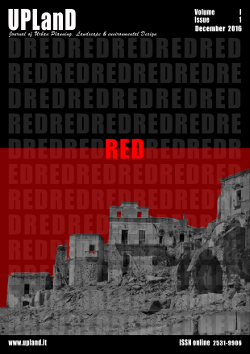For a territorial organization with variable geometry
Main Article Content
Abstract
Motivated primarily by the need to control public spending, law 56/14 Measures for metropolitan cities, provinces, unifications and mergers of communes, led to a new institutional architecture of the State, but also to non-negligible impacts on governing territories of a large area.
It is obvious that regions, provinces and municipalities intersect in their spatial and demographic dimensions. However, when one wants to review a layout for general reasons, and — perhaps — for the sake of simplification, one cannot exempt it from an assessment of the geographical and demographic realities of the real Italian territories. Investigating territorial planning functions for the coordination of the Provinces is of crucial importance. The reform, for now incomplete, does not seem to have solved the historical weakness on the planning level for boundaries that are not yet well defined. The ability of new institutional architectures to grasp the dynamics of large areas remains to be proven.Downloads
Download data is not yet available.
Article Details
How to Cite
TiraM. (2016). For a territorial organization with variable geometry. UPLanD - Journal of Urban Planning, Landscape & Environmental Design, 1(1), 257. https://doi.org/10.6093/2531-9906/5041
Issue
Section
Articles

This work is licensed under a Creative Commons Attribution-NonCommercial-NoDerivatives 4.0 International License.
Authors who publish with this journal agree to the following terms:- Authors retain copyright and grant the journal right of first publication with the work simultaneously licensed under a Creative Commons Attribution License that allows others to share the work with an acknowledgement of the work's authorship and initial publication in this journal.
- Authors are able to enter into separate, additional contractual arrangements for the non-exclusive distribution of the journal's published version of the work (e.g., post it to an institutional repository or publish it in a book), with an acknowledgement of its initial publication in this journal.
- Authors are permitted and encouraged to post their work online (e.g., in institutional repositories or on their website) prior to and during the submission process, as it can lead to productive exchanges, as well as earlier and greater citation of published work (See The Effect of Open Access).
References
Bagnasco A. (1977), Tre Italie. La problematica territoriale dello sviluppo italiano, Il Mulino, Bologna
Camagni R and Pio A. (1988), Struttura economica e gerarchia metropolitana europea: la posizione di Milano nel sistema dell’Europa centro-meridionale, in IRER (Ed.) Progetto Milano. La trasformazione economica della città, Franco Angeli, Milano, pp. 59-122
Camagni R. and Lombardo S. (eds.) (1999) La città metropolitana: strategie per il governo e la pianificazione, Alinea, Firenze, ISBN-10: 8881253445
CEC [1999], Schema di Sviluppo dello Spazio Europeo, Bruxelles
Kunzmann K. R. and M. Wegener, The pattern of urbanization in Western Europe, Ekistics, 350, 1991
RECLUS/DATAR (1989), Les villes européennes, La Documentation Française, Paris
Spaziante A. (Ed.) (2003), Pianificazione strategica per le città: riflessioni dalle pratiche, Franco Angeli, Milano, ISBN: 9788846449887
Testa P, (ed.) (2013), Le città metropolitane, Edizioni Cittalia, ISBN: 978-88-6306-035-5
Tira, M (2014) Verso un territorio a geometria variabile, Ingenio, no. 19, ISSN 2307-8928
Richiedei A. and M. Tira (2010), Impatti e costi della crescita urbana, in: Atti della XXXI Conferenza Scientifica AISRe - XLVII Colloque de l'ASRDLF, Aosta, CD
Tira M. (2015), Potenzialità e limiti della legge urbanistica regionale lombarda e qualche significato per il Piano urbanistico, in: Martinico F. (Ed.), Ricerca, didattica e prassi urbanistica nelle città del Mediterraneo. Scritti in onore di Giuseppe Dato, Gangemi, Roma, EAN: 9788849222203
Tira M., Van der Krabben E. and Zanon B. (2011), Land management for urban dynamics. Innovative methods and practices in a changing Europe, Maggioli, Rimini, ISBN 8838760667
Camagni R and Pio A. (1988), Struttura economica e gerarchia metropolitana europea: la posizione di Milano nel sistema dell’Europa centro-meridionale, in IRER (Ed.) Progetto Milano. La trasformazione economica della città, Franco Angeli, Milano, pp. 59-122
Camagni R. and Lombardo S. (eds.) (1999) La città metropolitana: strategie per il governo e la pianificazione, Alinea, Firenze, ISBN-10: 8881253445
CEC [1999], Schema di Sviluppo dello Spazio Europeo, Bruxelles
Kunzmann K. R. and M. Wegener, The pattern of urbanization in Western Europe, Ekistics, 350, 1991
RECLUS/DATAR (1989), Les villes européennes, La Documentation Française, Paris
Spaziante A. (Ed.) (2003), Pianificazione strategica per le città: riflessioni dalle pratiche, Franco Angeli, Milano, ISBN: 9788846449887
Testa P, (ed.) (2013), Le città metropolitane, Edizioni Cittalia, ISBN: 978-88-6306-035-5
Tira, M (2014) Verso un territorio a geometria variabile, Ingenio, no. 19, ISSN 2307-8928
Richiedei A. and M. Tira (2010), Impatti e costi della crescita urbana, in: Atti della XXXI Conferenza Scientifica AISRe - XLVII Colloque de l'ASRDLF, Aosta, CD
Tira M. (2015), Potenzialità e limiti della legge urbanistica regionale lombarda e qualche significato per il Piano urbanistico, in: Martinico F. (Ed.), Ricerca, didattica e prassi urbanistica nelle città del Mediterraneo. Scritti in onore di Giuseppe Dato, Gangemi, Roma, EAN: 9788849222203
Tira M., Van der Krabben E. and Zanon B. (2011), Land management for urban dynamics. Innovative methods and practices in a changing Europe, Maggioli, Rimini, ISBN 8838760667

